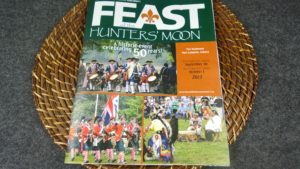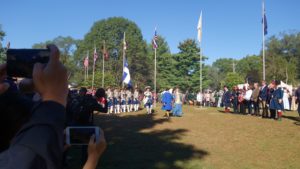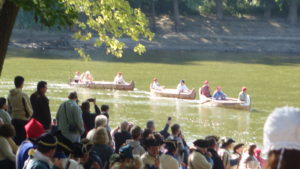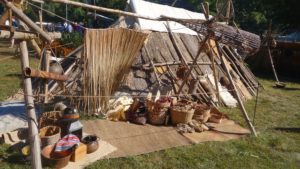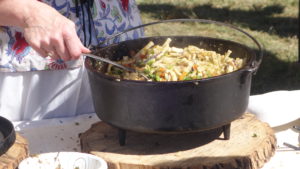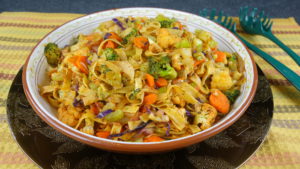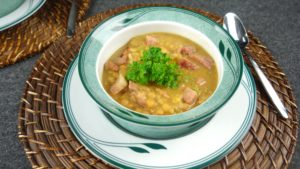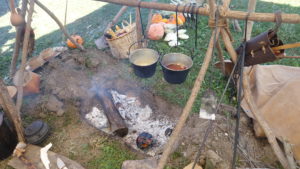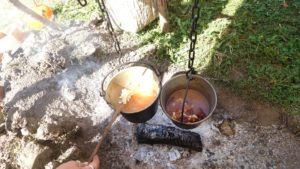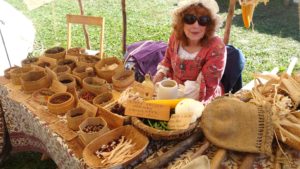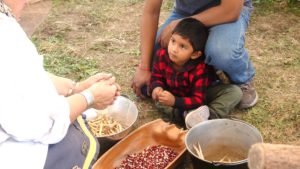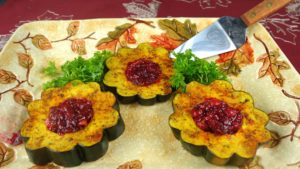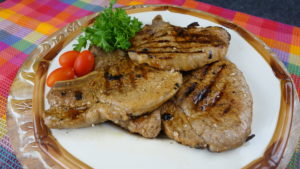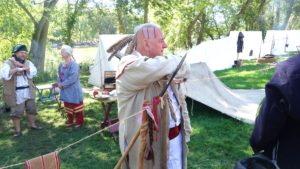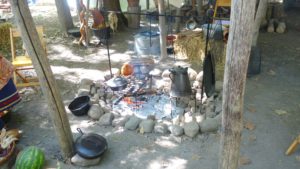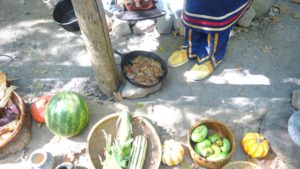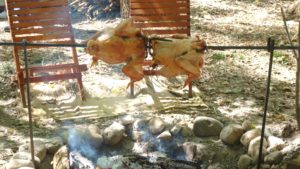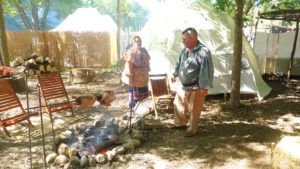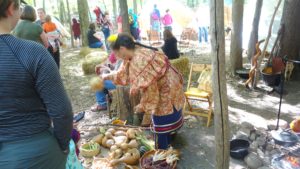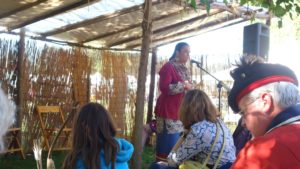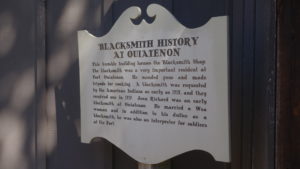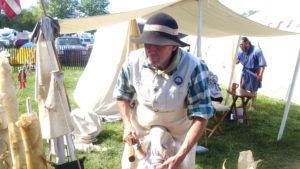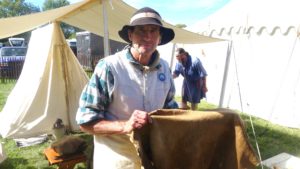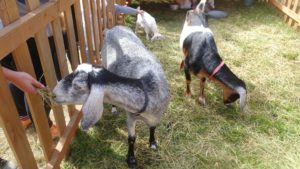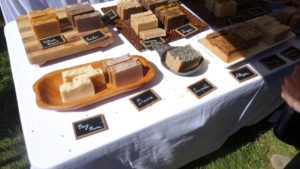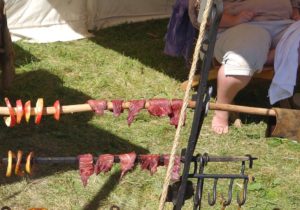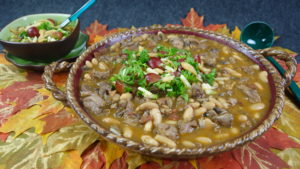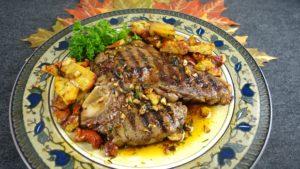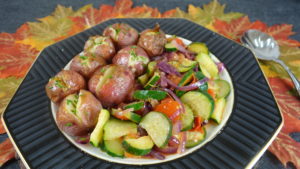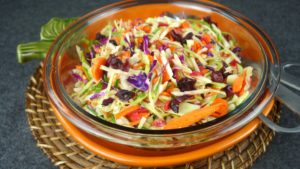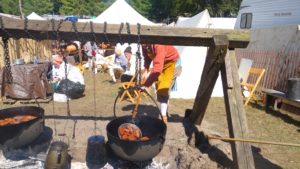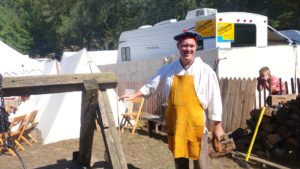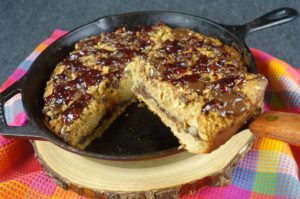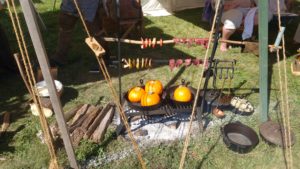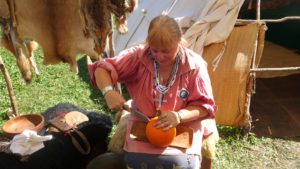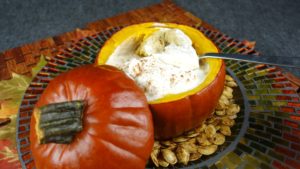+++++++++++++++++++++++++++++++++++++++++++++++++++++
Live the Pioneer Spirit
+++++++++++++++++++++++++++++++++++++++++++++++++++++
As we forge through life, it’s helpful to glance backwards to visualize early pioneers, immigrants, and explorers as they demonstrated tremendous courage and inner fortitude. They share, teach, and guide us by their examples.
Imagine the smell of wood smoke, hearing the firing of the rifles, savoring authentic foods, learning the crafts, and hearing the Native American chants and music. What a great way to experience the pioneer spirit! So today we say: Welcome to the 50th annual Feast of the Hunters’ Moon and the 300th anniversary of the establishment of Fort Quiatenon. It’s 1717 – come along with us and 58,218 others to experience this living history.
+++++++++++++++++++++++++++++++++++++++++++++++++++++
Feast of the Hunters’ Moon
It happens right before your eyes, the colonial frontier of the Great Lakes region becomes real as the voice of the coordinator, Leslie Conwell narrates the opening ceremony. She retells how the Fort’s cultures came together, surrounded by music from Native Americans and the marching fife and drum corps during the Opening Ceremonies. You find yourself surrounded by participants dressed in the garb of the 18th century French soldiers, settlers, and Native Americans, who lived in this region
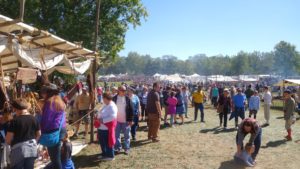
Feast of the Hunters’ Moon – Sept 3oth & Oct 1st, 2017 in West Lafayette, Indiana— Go Back in History to the Year 1717
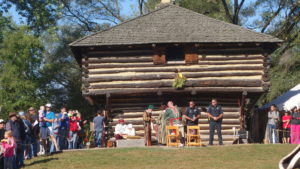
Replica of Original Fort Quiatenon along Wabash River – 1 mile from the Original Archeaological Location
‘
‘
‘
‘
‘
‘
‘
‘
‘
‘
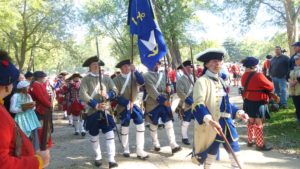
Rennactment and Pagentry of the Time during It’s 300 yr History as French Soldiers Parade Toward River Landing
‘
‘
‘
‘
‘
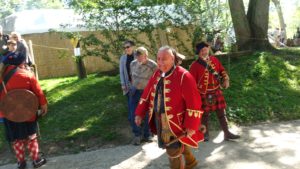
Wea Tribe – Local Native Americans who would have greeted French Traders and Exchanged Furs for Various Goods and Services at Fort Quiatenon
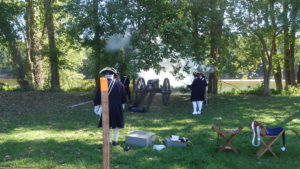
Many Battles Took Place at Fort Quiatenon between Waring Factions in its Earliest History to Defend Territorial Claims
‘
‘
‘
‘
‘
‘
‘
Wea Elder Native American Interview
+++++++++++++++++++++++++++++++++++++++++++++++++++++
Early Cooking Methods Used by Pioneers and Recreated at the Feast
Cooking at the Fort
The Fort expanded several times and by 1761 consisted of a stockade fence surrounding a double row of 14 houses. It had a chapel and blacksmith shop and housed about 20 soldiers and about a dozen traders. Voyageurs stayed there during the winter months. Fort Quiatenon became a highly profitable outpost of the French empire in North America.
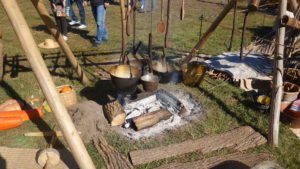
Early Pioneer Cooking Methods Recreated at the Feast in Open Cast Iron Pots -Cooked Low and Slow for Stews and Soups
‘
‘
‘
‘
‘
‘
Smoky, savory and sweet aromas fill the air from the vendors that are preparing favorite colonial and native foods. During this period of history, Fort Quiatenon attracted a variety of natives and Europeans including Wea families, French-Canadian traders, British soldiers, some Virginia troops, Kickapoo, and Mascoutin, Native American tribes. The food naturally reflected a blend of these cultures with a strong influence of French cuisine, making its way from the Canadian French-born and New France.
+++++++++++++++++++++++++++++++++++++++++++++++++++++
Feast of the Hunters’ Moon – Noodleables
‘
About the Recipe: Everyone who buys this at the Feast of the Hunters’ Moon loves it. It’s full of vegetables and can be made without the bacon for a vegetarian main dish. We enjoyed serving some crusty bread and crackers with it. If you add broth to it, it becomes a delicious soup too.
+++++++++++++++++++++++++++++++++++++++++++++++++++++
Voyageur Stew
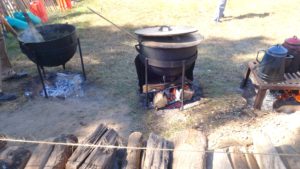
Voyageur Stew Being Cooked at the Feast of the Hunters’ Moon by John Phillips & Boy Scout Troop #326 from Crawfordsville, Indiana
‘
About the Recipe: Pioneer stews like this one use only a few seasonings. Pork trimmings from the trappers were added for additional flavor. Bacon or chopped smoked ham adds a delightful grilled flavor to the split peas. If desired, add additional herbs and ingredients as suggested in the Recipe Additions.
+++++++++++++++++++++++++++++++++++++++++++++++++++++
Pioneer Cooking
‘
‘
‘
‘
‘
‘
‘
‘
‘
‘
‘
An important part of cooking was learning how to control the fire. Open hearth cooking was used before cooking stoves existed, and fireplaces were also commonly used. Hardwoods were the best fuel to use.
While a blazing fire looks dramatic, they weren’t very useful for cooking.
Cooks needed a controllable fire to roast and toast foods. Soups and stews that needed simmering were done under a small flame. Dutch oven used coals that were placed on the lid and underneath to bake.
With cold winters, it was important to preserving foods by pickling, drying, salting, and smoking. Since voyageurs needed to travel, jerky became a popular food choice.
Alice Caroline and Cindy Kay Deardorff brought lots of beans, seeds, and vegetables to the Feast and explained how they were used by Habitants at the fort.
https://www.nps.gov/fosc/learn/education/cookhearth.htm
http://www.theprepperdome.com/pioneer-cooking-methods-and-recipes/
+++++++++++++++++++++++++++++++++++++++++++++++++++++
Golden Acorn Squash Rings with Fresh Cranberries
About the Recipe: Sweet golden autumn squash is the star of this dish and perfect for those holiday parties. Whole berry cranberry sauce brings delightful flavor and accents the roasted squash. You almost forget that this dish is a powerhouse of nutrition on a plate.
+++++++++++++++++++++++++++++++++++++++++++++++++++++
Pork Chops with Sizzle Sauce
About the Recipe: Thousands of people enjoyed this recipe at the Feast of the Hunters’ Moon. The meat is very moist and the cloves and ginger give it a baked ham flavor. It’s an easy main dish to prepare, grilled inside on a grill pan or an outdoor grill.
++++++++++++++++++++++++++++++++++++++++++++++++++
Native American Wea Village
Meet the Wea Native Americans:
Their summer village lay on the south side of the river on high ground to the west of a small creek. There were little cabins that housed extended families and wigwams circled around the camp. Communal fields of corn, beans, and squash were cultivated by the Wea women. Pumpkins were used to create savory as well as sweet dishes. The men were very skilled at hunting, resulting in peaceful relationships with the French traders.
A Native American Elder White Crow told us more about their tribes.
‘
‘
‘
‘
‘
‘
‘
‘
‘
‘
‘
‘
‘
‘
‘
‘
‘
The Wea provided the major food source, which included maize, squash, and beans while the French introduced cattle and hogs They grew small gardens, but wild game, fish, and fowl were their main sources of protein. Local ingredients including nuts, fruits, and berries were used along with an occasional shipment of wheat flour.
Debbie Brown – Wea Descendant Interview
+++++++++++++++++++++++++++++++++++++++++++++++++++++
Native American Story Telling
Meet a Native American Story Teller:
Native Americans understand that stories help us to see the patterns of life, making it easier to deal with personal and emotional experiences. Stories can delight, teach, inspire, motivate, and enchant us. They are so powerful and create pictures in our mind helping us remember events and consequences. Native Americans have a rich oral tradition of sharing their history, customs, rituals, legends, and lessons through vivid stories. We spoke to Judy Camp, a Native American who represented the Pottawatomi People of the Great Lakes and member of the Algonquian family. These are the Native Americans from the Great Plains, upper Mississippi River and Western Great Lakes region, who shared her culture with the people at the Feast.
+++++++++++++++++++++++++++++++++++++++++++++++++++++
Craftspersons at Fort Quiatenon
+++++++++++++++++++++++++++++++++++++++++++++++++++++
Blacksmiths Were Critical to a Settlement
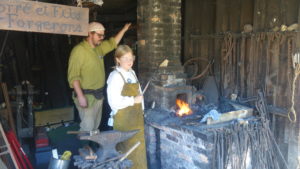
Young Apprentice “Raymond Kline” Working with Quiatenon Blacksmith to Develop Skills of Working with Ir
‘
‘
‘
‘
‘
‘
Meet a Blacksmith
Turning around, we saw a blacksmith, a muscular man heating iron in hot coals. He was creating objects by forging the metal into objects by hammering, bending, and cutting. The blacksmith was able to produce tools, nails, chains, cooking utensils, traps, and weapons. These services were shared with the Native Americans, who needed these objects…
Working with the blacksmith was a young boy Raymond. His father, Joe Kline, told us that he was really interested in learning about the skills of a blacksmith. As we watched this young man following every direction, it was amazing to see him filled with the joy of learning these new skills. He was living history to the fullest.
+++++++++++++++++++++++++++++++++++++++++++++++++++++
Tanners of Animal Hides
‘
‘
‘
‘
‘
Meet a Tanner:
As we walked back towards the river, we saw Daniel Vogt, a tanner, removing the hair from deer skin. Preserving hides and furs were important to people at this time since they supplied the warm jackets, pants, hats, and boots. As he worked, we could tell that a tanner required lots of time and patience. It was surprising how white the skin was and he explained how that beautiful tan color was created after the hair was removed.
Interview of Daniel Vogt – Deerskin Craftsman
+++++++++++++++++++++++++++++++++++++++++++++++++++++
Sutlers – Civilian Merchants
+++++++++++++++++++++++++++++++++++++++++++++++++++++
Soap Making from Goat’s Milk
As you might expect, sutlers were here selling their period-era wares and various crafts. Animal skins, baskets, toys, soap, toys, cast iron tools, wooden works of art, quilts, pottery, herbs, and so much more were available for us to purchase.
‘
‘
‘
‘
‘
‘
Meet a Soap Maker:
As we walked along, beautiful fresh smells were coming from one of the tents. I stopped and looked at the tables inside that were filled with bars of soap. They contained fragrances of fresh berries, nuts, and citrus scents. Angela Mercer from Still Water Farms smiled and told me that the soap was created from the milk of the goats that were in an enclosed area next to the tent. She explained that goat milk helps your skin appear younger and smoother. It’s full of Vitamin A, which is great for repairing skin tissues and is a great moisturizer with all that cream in it. Just imagine all that plus an autumn burst of cranberries in one bar of soap. I just had to buy that one.
+++++++++++++++++++++++++++++++++++++++++++++++++++++
Voyageurs Jerky
With cold winters, it was important to preserving foods by pickling, drying, salting, and smoking. Since voyageurs needed to travel, jerky became a popular food choice.
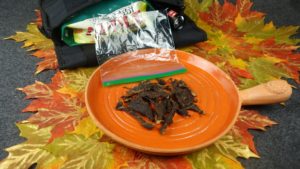
Updated Voyageur Jerky – As Native American and Pioneer’s Would have Done Because of a Lack of Refrigeration in Preserving Food/Meats
About the Recipe: This recipe is very easy to prepare and the chewy crisp jerky is perfect as a take-along on a camping trip or a backpacking walk-about.
+++++++++++++++++++++++++++++++++++++++++++++++++++++
French Inspired Chicken Chili
About the Recipe: Main dishes that simmered for a long time over a hot fire were common at this time. Many different meats could be used but fowl was plentiful. Soaking in red wine or using brandy tenderized the meat and gave it delicious taste. This recipe uses stronger spices like chili powder that weren’t available but peppered herbs or foraged ingredients were added to enhance the flavor. Enjoy this updated chili that has a mellow delicious starting taste followed by a hot peppered pop at the end.
+++++++++++++++++++++++++++++++++++++++++++++++++++++
Mushroom “Surf” and “Turf” T-Bone steak
About the Recipe: If you have a special occasion, celebrate by preparing this dish. It’s elegant, soul sizzling and delightfully delicious. The lobster mushrooms add the “surf” taste with their light “seafood” flavor and texture. Their “lobster” mushroom buttery sauce drizzles over the steak creating a beautiful marriage of flavors.
+++++++++++++++++++++++++++++++++++++++++++++++++++++
Salt-Crusted Rosemary Roasted Potatoes
About the Recipe: This recipe will become your favorite ‘go to” side dish. Covering the potatoes with herbs and kosher salt; they bake in a very hot oven and the protective potato skins lock in the moisture, creating tender addictive little packets of goodness.
+++++++++++++++++++++++++++++++++++++++++++++++++++++
Rainbow Confetti Coleslaw
About the Recipe: Coleslaw is the perfect side dish to serve for everyday suppers or informal parties. The vibrant colors of this salad give the dish a beautiful artistic flair. The salad is dressed with a light honey mustard garden dressing and dotted with sweet dried cranberries.
+++++++++++++++++++++++++++++++++++++++++++++++++++++
Lions Clubs’ – Les Croquignoles
About the Recipe: I remember my grandmother frying up crisp pieces of dough that were made for special occasions and sprinkling them with cinnamon and sugar. She mixed them up the old fashioned way and never followed a printed recipe
This web recipe appeared to be easiest to prepare. Many recipes for this pastry use a standard donut dough or modified mashed potato mixture. The vendors at the Feast said that they used donut dough for their pastry. Some toss with confectioners’ sugar but the Lions Club at the Feast served their pastry coated with a strong cinnamon sugar.
+++++++++++++++++++++++++++++++++++++++++++++++++++++
Smoked Almond Butter Coffee Cake with Drizzles of Raspberry and Dark Chocolate
About the Recipe: This easy-to-make coffee cake, baked in a cast iron skillet, is filled with almond butter flavor, a chocolate nut spread filling, and topped with crunchy smoked almond crumble. Drizzles of dark chocolate and fruit fresh raspberry jam swirl around the top. It’s perfect for breakfast, brunch, or even dessert.
+++++++++++++++++++++++++++++++++++++++++++++++++++++
Just for Fun
+++++++++++++++++++++++++++++++++++++++++++++++++++++
Colonial Custard Pie Pumpkin Dessert
‘
To Serve: Place dollops of Maple Pumpkin Pie Whipped Cream inside pumpkin; lightly sprinkle with pumpkin pie spice if desired. Garnish serving plate with Sweet ‘n Salty Pumpkin Seeds. See attached recipes…
Let guests use serving spoon to remove soft pumpkin, custard and whipped cream to dessert plates. Serve additional whipped cream and pumpkin seeds on the side.
+++++++++++++++++++++++++++++++++++++++++++++++++++++
![]()

